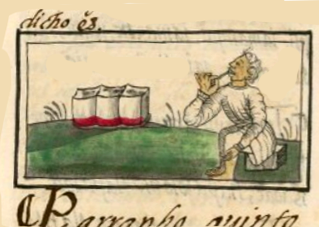tlantli (FCbk10f77v)
This iconographic example, featuring human teeth (tlantli), is included in this digital collection for the purpose of making comparisons with related hieroglyphs. The term selected for this example comes from the text on the same page as the image in the Digital Florentine Codex. There is no gloss, per se. This example shows three, rectagonal, white teeth with a row of red color at their base, apparently representing a gum line. These teeth sit on the ground, which is covered with green grass. Having a ground shows European artistic influence. The contextualizing image includes a man in a ¾ view, facing left, toward the teeth on the ground, but he is focused on putting a short stick or pick up to his own teeth, which are visible. He is wearing a white cotton, belted, long-sleeve tunic with ruffles on the wrists. He also has calf-length pants. These are European-style garments and they are shaded to show three-dimensionality, another European artistic influence.
Stephanie Wood
Nahuatl hieroglyphs of tlantli typically have a bit of gum showing at the top, and they are usually in pairs, such as two front teeth. There are, however, examples of three or four teeth, and sometimes the suggestion of an entire mouthful of teeth. The human teeth in this collection are typically employed as phonetic indicators for the locative -tlan or the syllable -tla-.
Stephanie Wood
tlantli
Stephanie Wood
1577
Jeff Haskett-Wood
diente, encía, encías, palillo, palillos
tlan(tli), tooth, teeth, https://nahuatl.wired-humanities.org/content/tlantli
los dientes
Stephanie Wood
Available at Digital Florentine Codex/Códice Florentino Digital, edited by Kim N. Richter and Alicia Maria Houtrouw, "Book 10: The People", fol. 77v, Getty Research Institute, 2023. https://florentinecodex.getty.edu/en/book/10/folio/77v/images/0 Accessed 10 September 2025.
Images of the digitized Florentine Codex are made available under the following Creative Commons license: CC BY-NC-ND (Attribution-NonCommercial-NoDerivs 4.0 International). For print-publication quality photos, please contact the Biblioteca Medicea Laurenziana ([email protected]). The Library of Congress has also published this manuscript, using the images of the World Digital Library copy. “The Library of Congress is unaware of any copyright or other restrictions in the World Digital Library Collection. Absent any such restrictions, these materials are free to use and reuse.”








